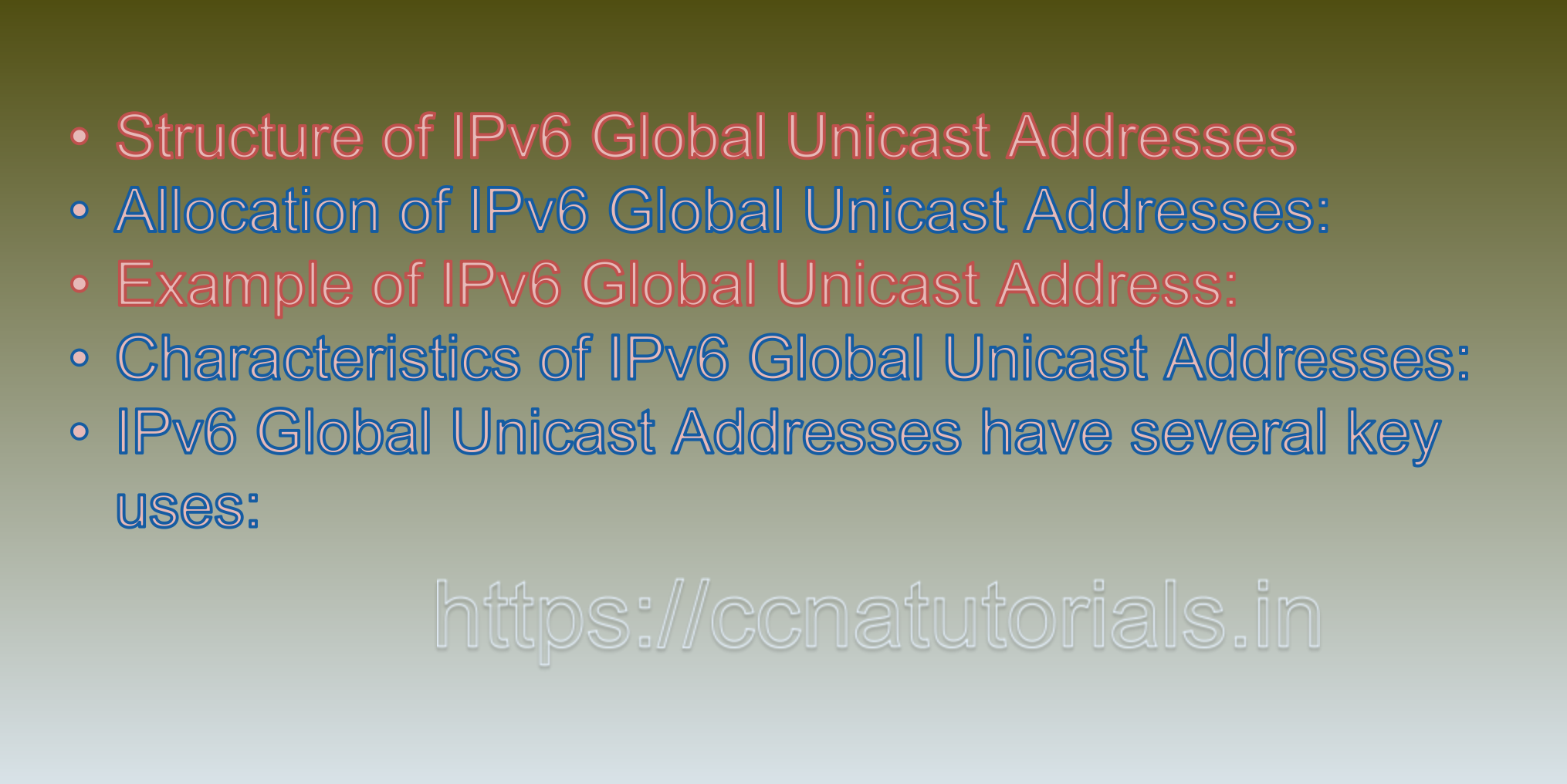Contents of this article
In this article, I describe IPv6 Global Unicast Addresses. IPv6 Global Unicast Address are a type of IPv6 address used for global communication on the Internet. These addresses uniquely identify devices or interfaces on the global IPv6 network and are publicly routable. Global Unicast Address are assigned to devices that require direct communication with other devices across different networks and are a key component of the global IPv6 address space. In this guide, we’ll explore the concept of IPv6 Global Unicast Address, their structure, allocation, and examples.
Structure of IPv6 Global Unicast Addresses:
IPv6 Global Unicast Address are divided into different parts that convey specific information:
1. Global Routing Prefix:
The global routing prefix is a portion of the address that identifies the network’s address space and routing location. It is assigned by an Internet Service Provider (ISP) or organization.
2. Subnet ID:
The subnet ID identifies a specific subnet within the assigned network. It allows for further segmentation and addressing within the network.
3. Interface Identifier:
The interface identifier uniquely identifies a device or interface within the subnet. It can be derived from the device’s MAC address, although Privacy Extensions can also be used to enhance privacy.
Allocation of IPv6 Global Unicast Addresses:
IPv6 Global Unicast Addresses are allocated by Regional Internet Registries (RIRs) to Internet Service Providers (ISPs) and organizations. These allocations follow hierarchical address assignment to ensure efficient utilization of the IPv6 address space.
Example of IPv6 Global Unicast Address:
Assume an organization receives a global routing prefix `2001:0db8:1234:abcd::/48` from their ISP and decides to allocate a subnet ID of `::/64` for each subnet within their network.
For a device with MAC address `00:1A:2B:3C:4D:5E` connected to the subnet, the interface identifier is derived using the EUI-64 format:
1. Convert the MAC address to modified EUI-64 format: `001A:2BFF:FE3C:4D5E`
2. Combine the global routing prefix, subnet ID, and interface identifier to create the IPv6 Global Unicast Address:
2001:0db8:1234:abcd::001A:2BFF:FE3C:4D5E
Usage and Importance:
IPv6 Global Unicast Addresses are used for direct communication between devices on the global IPv6 network. They play a vital role in enabling end-to-end communication and facilitating the growth and expansion of the Internet.
Conclusion for IPv6 Global Unicast Addresses:
IPv6 Global Unicast Addresses are essential for global communication on the Internet. Their structured format, allocation mechanisms, and hierarchical design ensure efficient addressing and routing within the vast IPv6 address space. By providing a unique identifier for devices on the global network, Global Unicast Addresses are a cornerstone of IPv6’s ability to connect devices and enable seamless communication across the modern digital landscape.

IPv6 Global Unicast Address explained via another approach
IPv6 Global Unicast Address are a type of IPv6 address used for identifying devices and enabling communication on the global Internet. Unlike link-local addresses or Unique Local Address (ULAs), which are limited to local or private networks, global unicast address are routable across the entire IPv6 Internet. In this guide, we’ll explore the concept of IPv6 Global Unicast Address, their structure, characteristics, and examples.
Characteristics of IPv6 Global Unicast Addresses:
1. Global Routability:
Global Unicast Address are designed for communication over the global IPv6 Internet. They are used to uniquely identify devices and enable them to communicate across different networks and regions.
2. Address Range:
IPv6 Global Unicast Addresses are defined in RFC 4291 and fall within the address range `2000::/3`. This address space is divided into subnets assigned to various organizations and Internet service providers.
3. Interface Identifier:
The interface identifier portion of a Global Unicast Address is used to uniquely identify a specific device within a network. It is often derived from the device’s Media Access Control (MAC) address or generated using Privacy Extensions.
4. Autoconfiguration:
Like other IPv6 address types, Global Unicast Addresses can be configured manually or generated automatically through Stateless Address Autoconfiguration (SLAAC) or Dynamic Host Configuration Protocol for IPv6 (DHCPv6).
5. Scope Identifier:
As with other IPv6 addresses, a scope identifier can be appended after the address, separated by a percent sign (%). For example: `2001:db8::1% eth0`.
Uses of IPv6 Global Unicast Addresses:
IPv6 Global Unicast Address have several key uses:
1. Internet Communication:
Global Unicast Address are essential for enabling devices to communicate over the global IPv6 Internet. They are used in routing and forwarding packets between different networks.
2. End-to-End Connectivity:
Global Unicast Addresses provide end-to-end connectivity for applications and services, allowing devices to communicate directly with each other across the Internet.
3. Global Reachability:
Devices with Global Unicast Addresses can reach any other device with a globally routable IPv6 address, enabling seamless global communication.
4. Network Services:
Global Unicast Addresses are used to identify network devices, servers, and services accessible over the Internet.
Example of IPv6 Global Unicast Address:
Assume you have been assigned a block of IPv6 addresses for your organization’s network. You decide to use the prefix `2001:0db8:1234::/48` for your devices.
1. Subnet Identifier:
For a specific subnet within your network, you assign a subnet identifier. Let’s use `0001` as the subnet identifier.
2. Interface Identifier:
For a device on this subnet, you derive the interface identifier from its MAC address, resulting in `001A:2BFF:FE3C:4D5E`.
3. Combine the prefix, subnet identifier, and interface identifier to create the Global Unicast Address:
`2001:0db8:1234:0001:001A:2BFF:FE3C:4D5E`
Scope Identifier: If the Global Unicast Address is assigned to the `eth0` interface, you can add a scope identifier as follows:
`2001:0db8:1234:0001:001A:2BFF:FE3C:4D5E%eth0`
Conclusion for IPv6 Global Unicast Address:
IPv6 Global Unicast Address are fundamental for enabling communication across the global IPv6 Internet. These addresses uniquely identify devices and provide end-to-end connectivity, making them essential for applications, services, and network infrastructure that require global reachability. By understanding the structure and characteristics of Global Unicast Address, network administrators can effectively design and manage IPv6 networks that facilitate seamless and global communication. You may drop a comment below or contact us for any queries or suggestions related to this article.






